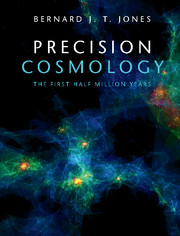Book contents
- Frontmatter
- Dedication
- Contents
- Preface
- Notation and Conventions
- Part I 100 Years of Cosmology
- Part II Newtonian Cosmology
- Part III Relativistic Cosmology
- 10 Minkowski Space
- 11 The Energy Momentum Tensor
- 12 General Relativity
- 13 Space-Time Geometry and Calculus
- 14 The Einstein Field Equations
- 15 Solutions of the Einstein Equations
- 16 The Robertson–Walker Solution
- 17 Congruences, Curvature and Raychaudhuri
- 18 Observing and Measuring the Universe
- Part IV The Physics of Matter and Radiation
- Part V Precision Tools for Precision Cosmology
- Appendix A SI, CGS and Planck Units
- Appendix B Magnitudes and Distances
- Appendix C Representing Vectors and Tensors
- Appendix D The Electromagnetic Field
- Appendix E Statistical Distributions
- Appendix F Functions on a Sphere
- Appendix G Acknowledgements
- References
- Index
13 - Space-Time Geometry and Calculus
from Part III - Relativistic Cosmology
Published online by Cambridge University Press: 04 May 2017
- Frontmatter
- Dedication
- Contents
- Preface
- Notation and Conventions
- Part I 100 Years of Cosmology
- Part II Newtonian Cosmology
- Part III Relativistic Cosmology
- 10 Minkowski Space
- 11 The Energy Momentum Tensor
- 12 General Relativity
- 13 Space-Time Geometry and Calculus
- 14 The Einstein Field Equations
- 15 Solutions of the Einstein Equations
- 16 The Robertson–Walker Solution
- 17 Congruences, Curvature and Raychaudhuri
- 18 Observing and Measuring the Universe
- Part IV The Physics of Matter and Radiation
- Part V Precision Tools for Precision Cosmology
- Appendix A SI, CGS and Planck Units
- Appendix B Magnitudes and Distances
- Appendix C Representing Vectors and Tensors
- Appendix D The Electromagnetic Field
- Appendix E Statistical Distributions
- Appendix F Functions on a Sphere
- Appendix G Acknowledgements
- References
- Index
Summary
Unlike Newton's theory of gravitation, Einstein's theory of general relativity views the gravitational force as a manifestation of the geometry of the underlying space-time. The idea sounds good, it evokes images of billiard balls rolling around on tables with hills and valleys where the balls’ otherwise rectilinear motion is disturbed by the geometry of their environment. The difficulty is how to achieve the parallel goal of expressing the force of gravitation geometrically, and to do so without destroying all that we have learned about physics in our local environment.
As we saw in the previous chapter, Einstein saw the principles of covariance and equivalence as a way of formalising that. The theory of gravitation should always admit local inertial frames in which our known laws of physics would hold. Moreover, the mathematical expression of the laws of physics would be the same in all inertial frames. A key step at this point was to argue that physical entities are described by mathematical objects that transform correctly under local Lorentz transformations. This brings us to Minkowski's use of 4-vectors and tensors as the mathematical embodiment of physical quantities.
However, these are local statements, not global ones. They do not tell us how the geometry would affect two widely separated inertial observers in the presence of a gravitational field. The clue was given to Einstein by Marcel Grossmann who suggested that this link would be provided by insisting that the underlying geometry was the geometry of a Riemannian space. This provides the structure to address global issues and to connect different parts of the space.
In this chapter we describe this process and provide the mathematical structure that arises when we follow up on Grossmann's plan. We learn about connecting parts of the space-time and we establish notions of derivatives, geodesics and measures of the curvature.
A Geometric Perspective
The space time of Einstein's theory is specified by its geometry. A gravitational field is thought of as distorting the space-time away from the no-gravity space-time of Minkowski. So, just as the Minkowski space of special relativity is entirely specified by a metric tensor or line element telling us what the space time separation of neighbouring points is, the space-time of the general theory is specified by a more general metric.
- Type
- Chapter
- Information
- Precision CosmologyThe First Half Million Years, pp. 307 - 339Publisher: Cambridge University PressPrint publication year: 2017

